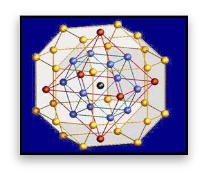Metals
Computer simulations of nanostructured systems
Our main goal is to understand magnetic, electronic and structural properties. We study different classes of nanostructured systems through Quantum Mechanics using computer algorithms which implement, in different ways, theoretical approaches based on the Density Functional Theory. This kind of study can give very precise information at the atomic level even considering some hundredths of atoms.
Example: Local magnetic properties in metallic nanoparticles in noble metal matrices.
Giant Magneto-Resistive (GMR) materials
 The GMR (theme of the Nobel prize in Physics in 2007) is also studied. This effect is very much dependent on the structural characteristics, and there are difficulties in the experimental characterization, that is, to understand how the local magnetic moment vary with the neighborhood: different magnetic behavior at interface or inner positions in the particle
The GMR (theme of the Nobel prize in Physics in 2007) is also studied. This effect is very much dependent on the structural characteristics, and there are difficulties in the experimental characterization, that is, to understand how the local magnetic moment vary with the neighborhood: different magnetic behavior at interface or inner positions in the particleStrategy: Combine hyperfine interaction measurements (NMR, Mössbauer Spectroscopy, etc.) and theoretical calculations to help in the structural and magnetic characterization in the atomic scale.
Non-collinear magnetism
The magnetism in systems with nanometric dimensions is actually a very important research field. This is due to the rapid technological developments of magnetic materials and new phenomena seen at the nanoscale. One of the magnetic properties of nanostructures which play an important role in the design of new magnetic devices is the magnetic interaction between the constituent atoms of a nanostructure. Depending on the strength and sign of the exchange interaction, the nanostructure can be driven into ferromagnetic (FM), antiferromagnetic (AFM) or complex spin structures (Non-collinear magnetism) [1].
Strategy: Research of metallic nanostructures supported on metallic surface by use of ab initio Real Space Linear Muffin Tin Orbital [2-3] enable us the treatment non-collinear magnetism.
[1] S. Lounis, P. H. Dederichs and S. Blugel, Phys. Rev. Lett. 101, 107204 (2008).
[2] S. Frota-Pessôa, Phys. Rev. B 69, 104401 (2004);Phys. Rev. B 46, 14570 (1992); P. R. Peduto, S. Frota-Pessôa and M. S. Methfessel, Phys. Rev. B 44, 13 283 (1991); H. M. Petrilli and S. Frota-Pessôa, Phys. Rev. B 48 (1993).
[3] A. Bergman, L. Nordstrom, A. B. Klautau, S. Frota-Pessôa and O. Eriksson, Phys. Rev. B 73, 174434 (2006).
